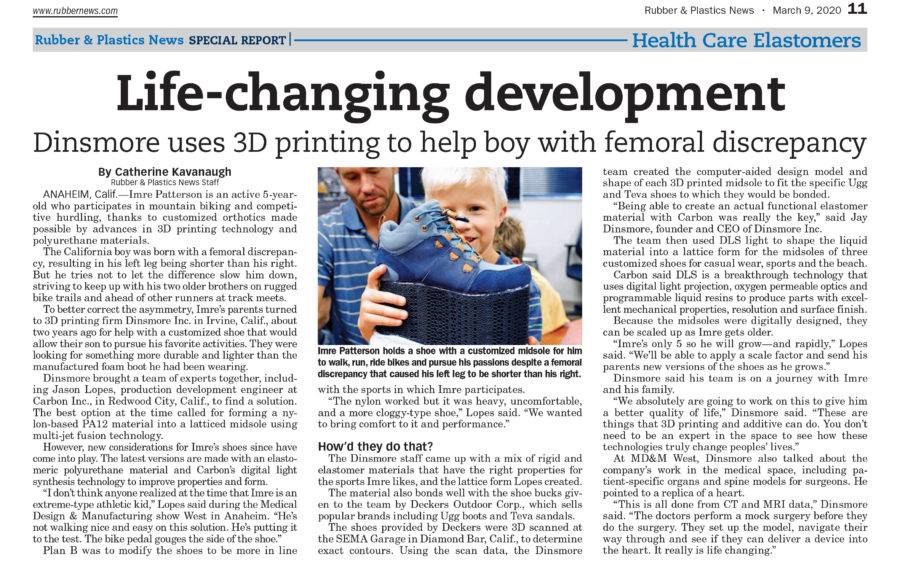
3D Printing • Design for Prototyping • Dinsmore News • Medical • Press Coverage
Imre Patterson Story – Life-changing Development
Imre Patterson is an active 5-year-old who participates in mountain biking and competitive hurdling, thanks to customized orthotics made possible by advances in 3D printing technology and polyurethane materials.
Anaheim, Calif. — Imre Patterson is an active 5-year-old who participates in mountain biking and competitive hurdling, thanks to customized orthotics made possible by advances in 3D printing technology and polyurethane materials.
The California boy was born with a femoral discrepancy, resulting in his left leg being shorter than his right. But he tries not to let the difference slow him down, striving to keep up with his two older brothers on rugged bike trails and ahead of other runners at track meets.
To better correct the asymmetry, Imre’s parents turned to 3D printing rm Dinsmore Inc. in Irvine, Calif., about two years ago for help with a customized shoe that would allow their son to pursue his favorite activities. They were looking for something more durable and lighter than the manufactured foam boot he had been wearing.
Dinsmore brought a team of experts together, including Jason Lopes, production development engineer at Carbon Inc., in Redwood City, Calif., to find a solution. The best option at the time called for forming a nylon 12 material into a latticed midsole using multijet fusion technology.
However, new considerations for Imre’s shoes have since come into play. The latest versions are made with an elastomeric polyurethane material and Carbon’s digital light synthesis (DLS) technology to improve properties and form.
“I don’t think anyone realized at the time that Imre is an extreme-type athletic kid,” Lopes said during the Medical Design & Manufacturing show in Anaheim. “He’s not walking nice and easy on this solution. He’s putting it to the test. The bike pedal gouges the side of the shoe.”
Plan B was to modify the shoes to be more in line with the sports in which Imre participates. “The nylon worked, but it was heavy, uncomfortable and a more cloggy-type shoe,” Lopes said. “We wanted to bring comfort to it and performance.”
How’d they do that?
The Dinsmore staff came up with a mix of rigid and elastomer materials that have the right properties for the sports Imre likes and the lattice form Lopes created.
The material also bonds well with the shoe bucks given to the team by Deckers Outdoor Corp., which sells popular brands like Ugg boots and Teva sandals.
The shoes provided by Deckers were 3D scanned at the SEMA Garage in Diamond Bar, Calif., to determine exact contours. Using the scan data, the Dinsmore team designed the computer-aided design model and shape of each 3D printed midsole to fir the specific Ugg and Teva shoes to which they would be bonded.
“Being able to create an actual functional elastomer material with Carbon was really the key,” said Jay Dinsmore, founder and CEO of Dinsmore Inc.
The team then used DLS light to shape the liquid material into a lattice form for the midsoles of three customized shoes for casual wear, sports and the beach.
Carbon said DLS is a breakthrough technology that uses digital light projection, oxygen permeable optics and programmable liquid resins to produce parts with excellent mechanical properties, resolution and surface finish.
Because the midsoles were digitally designed, they can be scaled up as Imre gets older. “Imre’s only 5 [years old], so he will grow — and rapidly,” Lopes said. “We’ll be able to apply a scale factor and send his parents new versions of the shoes as he grows.”
Dinsmore said his team is on a journey with Imre and his family.
“We absolutely are going to work on this to give him a better quality of life,” Dinsmore said. “These are things that 3D printing and additive can do. You don’t need to be an expert in the space to see how these technologies truly change peoples’ lives.”
At MD&M West, Dinsmore also talked about the company’s work in the medical space, including patient-specific organs and spine models for surgeons. He pointed to a replica of a heart.
“This is all done from CT and MRI data,” Dinsmore said. “The doctors perform a mock surgery before they do the surgery. They set up the model, navigate their way through and see if they can deliver a device into the heart. It really is life-changing.”
Original News Article : Plastics News
By : Catherine Kavanaugh
